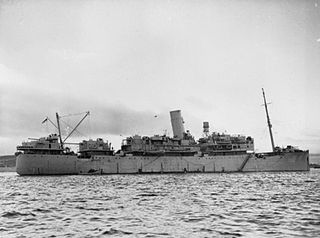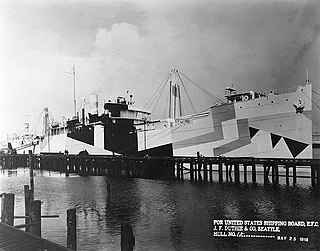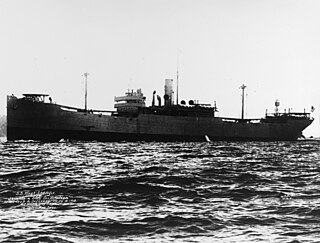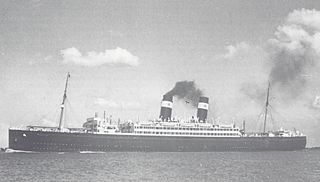
Alan-A-Dale was a cargo motor ship that was built in Denmark in 1938 as Nordvest. In the Second World War the United States requisitioned her in 1941 and renamed her Alan-A-Dale. In 1944 she was sunk by enemy action off the coast of the Netherlands.

HMS Cheshire was a passenger ship that was built in Scotland in 1927 and scrapped in Wales in 1957. She belonged to Bibby Line, which ran passenger and cargo services between Rangoon in Burma and various ports in Great Britain, via the Suez Canal and Gibraltar. The Admiralty requisitioned her in 1939 and had her converted into an armed merchant cruiser (AMC). She was converted into a troopship in 1943, and returned to civilian service in 1948.

SS Ceramic was an ocean liner built in Belfast for White Star Line in 1912–13 and operated on the Liverpool – Australia route. Ceramic was the largest ship serving the route until P&O introduced RMS Mooltan in 1923.

SS Somersby was a British cargo steamship that was built in 1930, sailed in a number of convoys in the Second World War and was sunk by a U-boat in 1941.

USS West Bridge (ID-2888) was a Design 1013 cargo ship in the United States Navy during World War I. She was begun as War Topaz for the British Government but was completed as West Bridge. After being decommissioned from the Navy, the ship returned to civilian service as West Bridge, but was renamed Barbara Cates, and Pan Gulf over the course of her commercial career under American registry.
SS Tregenna was a cargo steamship that was launched in England in 1919 and sunk by a U-boat in the Battle of the Atlantic in 1940 with the loss of 33 of her 37 crew. She was laid down as War Bulldog, but the Hain Steam Ship Co bought her before she was completed and renamed her Tregenna.

USS West Lianga (ID-2758) was a cargo ship for the United States Navy during World War I. She was later known as SS Helen Whittier and SS Kalani in civilian service under American registry, as SS Empire Cheetah under British registry, and as SS Hobbema under Dutch registry.

USS West Ekonk (ID-3313) was a cargo ship for the United States Navy during World War I. She was later known as SS West Ekonk in civilian service under American registry, and as SS Empire Wildebeeste under British registry.

USS West Haven (ID-2159) was a steel–hulled freighter that served the United States Navy in World War I, and later servedin convoys in the Battle of the Atlantic in World War II.

SS Polar Chief was a merchant steamship that was built in England in 1897 and scrapped in Scotland in 1952. In her 55-year career she had previously been called Montcalm, RFA Crenella, Crenella, Rey Alfonso, Anglo-Norse and Empire Chief. Early in the First World War she spent eight months pretending to be the battleship HMS Audacious.
SS Canonesa was a refrigerated cargo steamship that was built in Ireland in 1920 and sunk by a u-boat in the Atlantic Ocean in 1940.
British Corporal was a 6,972 GRT tanker that was built in 1922 by Palmers Shipbuilding and Iron Company, Jarrow, Northumberland, United Kingdom. She was built for the British Tanker Company.

SS Themistocles was a UK steam ocean liner and refrigerated cargo ship. She was launched in 1910 in Ireland and scrapped in 1947 in Scotland. She was built for Aberdeen Line, White Star Line managed her for a few years, and she spent the latter part of her career with Shaw, Savill & Albion Line.
SS Hertford was a refrigerated cargo steamship that was launched in Germany in 1917, seized by the United Kingdom in 1920 as World War I reparations, and sunk by a U-boat in 1942 with the loss of four members of her crew.
SS Aguila was a British steam passenger liner. She was built in Dundee in 1917 and was sunk by enemy action in the North Atlantic in 1941. She belonged to Yeoward Line, which carried passengers and fruit between Liverpool, Lisbon, Madeira and the Canary Islands.

SS Pennland was a transatlantic ocean liner that was launched as Pittsburgh in Ireland in 1920 and renamed Pennland in 1926. She had a succession of UK, German and Dutch owners and operators. In 1940 she was converted into a troopship.
HMS Crispin was a British cargo steamship that was launched in England in 1934 and operated by Alfred Booth and Company between Liverpool and the east coast of South America. In 1940 the British Admiralty requisitioned her and had her converted into an ocean boarding vessel. In 1941 a U-boat sank her in the Battle of the Atlantic, killing 20 of her crew.
SS Algarve was a Danish cargo steamship that was built in 1921 for DFDS. After Germany invaded Denmark in April 1940 Algarve was transferred to the UK Ministry of War Transport. In 1941 an E-boat sank her with all hands in the North Sea.
SS Pennington Court was a British cargo steamship. She was launched in 1924 as Rochdale and renamed Pennington Court in 1927. In the Second World War she carried iron ore, grain and other supplies to Britain. She was sunk with all hands in the Battle of the Atlantic in 1942.

MV Deucalion was a Blue Funnel Line refrigerated cargo ship that was built in England in 1930 and sunk in the Second World War in 1942. She survived being damaged in the Liverpool Blitz in December 1940 and took part in two Malta convoys to relieve the Siege of Malta. She survived air attacks during the first of these, Operation Substance, in July 1941 but was lost on her second Malta Convoy, Operation Pedestal, in August 1942. This was the third of five Blue Funnel ships to be named after Deucalion, a mythological king of Thessaly in Ancient Greece.












